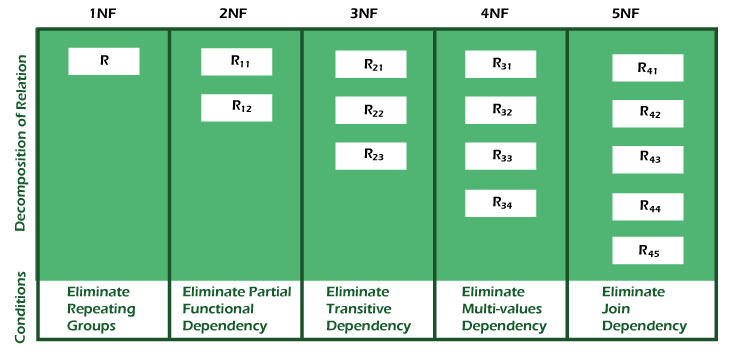Explain Normalization and Its Different Forms.
Most of todays transactional databases are normalized in third normal form 3NF. It is a multi-step process that puts data into tabular form removing duplicated data from the relation tables.

Dbms Normalization 1nf 2nf 3nf And Bcnf With Examples Javatpoint
Each cell must contain only a single atomic value.

. Database Normalization is a well-known technique used for designing database schema. Experts are tested by Chegg as specialists in their subject area. Second normal form 2NF.
It replaces a collection of data in a record structure by another record design which is simpler and more predictable. A table is said to be in first normal form if it has no repeating groups. First normal form relates to the duplication and over-grouping of data in tables and columns.
Normalization was developed by IBM researcher EF. Normalization is a process of organizing the data in database to avoid data redundancy insertion anomaly update anomaly deletion anomaly. All values in a column must pertain to the same domain.
1Normalisation is the process to organise database to reduce duplicacy and improve data integrity. The main purpose of applying the normalization technique is to reduce the redundancy and dependency of data. A relational table is a present third normal form if its in 2NF and also every Non-key column is non-transitively dependent upon its the primary key.
Nevertheless in most practical applications in the third normal form normalization does its best. The Boyce-Codd Normal Form or BCNF or 35 NF is a normal form which is slightly stronger than the 3NF. The values in an atomic domain are indivisible units.
It was developed in 1974 to address certain types of anomalies that were not dealt by 3NF. First Normal Forms 1Ne. Normalization is a method to remove all these anomalies and bring the database to a consistent state.
The third normal form can be described as Each an every column in a relational table is dependent only upon the primary key. Normal Forms of Normalization. First Normal Form is defined in the definition of relations tables itself.
Codeys Constructions table customers violates all three rules of 1NF. Normalization of a Database is achieved by following a set of rules called forms in creating the database. Third Normal Form 3NF.
Lets discuss about anomalies first then we will discuss normal forms with examples. Normalization is the process of minimizing redundancy from a relation or set of relations. As per this form no two rows could hav.
Database Normalization is a technique of organizing the data in the database. Forms of Normalization. NF refers to normal form First normal form 1NF Tables in 1NF must adhere to some rules.
The words normalization and normal form refer to the structure of a database. A user of the database would be forced to look up companies by their name which is not guaranteed to be unique since unique company names are. There are three types of anomalies that occur when the database is not normalized.
That is for each cell in a. Second normal form2NF Second Normal Form 2NF The type of entity is in 2NF when it is in 1NF and when all of its non-key attributes are entirely dependent on its primary key. This Tutorial will Explain what is Database Normalization and various Normal Forms like 1NF 2NF 3NF and BCNF With SQL Code Examples.
We review their content and use your feedback to keep the quality high. There are six normal Forms but in practice first second and third normal forms are widely used. One of the techniques used to eliminate the issues of data redundancy within a given database is Normalization.
Normal forms are used to eliminate or reduce redundancy in database tables. So it helps to minimize the redundancy in relations. For a database to satisfy a given level it must satisfy the rules of all lower levels as well as the rules for the given level.
Redundancy in relation may cause insertion deletion and update anomalies. First normal form1NF First normal form 1NF The type of entity is 1NF because it does not contain repeated data groups. Hadoop Data Science Statistics others.
A relational scheme once prepared in BCNF will remove all sorts of functional dependency though some other forms of redundancy can prevail. This rule defines that all the attributes in a relation must have atomic domains. Codd In the 1970s.
Normalization is a Six stage process - After the first stage the data is said to be in first normal form after the second it is in second normal form after. Normalization in DBMS is the process of effectively organizing data into multiple relational tables to minimize data redundancy. The three main types of normalization are listed below.
The most basic level of normalization is first normal form 1NF followed by second normal form 2NF. Normalization is a process of simplifying the relationship among data elements in a record. Normalization increases clarity in organizing data in Databases.
Every column in the table must be uniquely named. In SQL the Principle of Data Normalization is up-to-date. There are mainly six types of normalization in Database.
There is no primary key. Different forms of Normalisation. In this process we divide or breakdown the database into tables and a relationship is establishe.
It converts E-R model into Tables or Relations. Start Your Free Data Science Course. And on the 6th Standard Form for example there are conversations.
Normalization - it is a process of organizing the data into a related table it eliminates the redundancy and increases the performance of the query. Normalization is a systematic approach of decomposing tables to eliminate data redundancy repetition and undesirable characteristics like Insertion Update and Deletion Anomalies. The Normal Forms of the normalization are listed below.

Database Normalization Examples What Is Normalization


Comments
Post a Comment